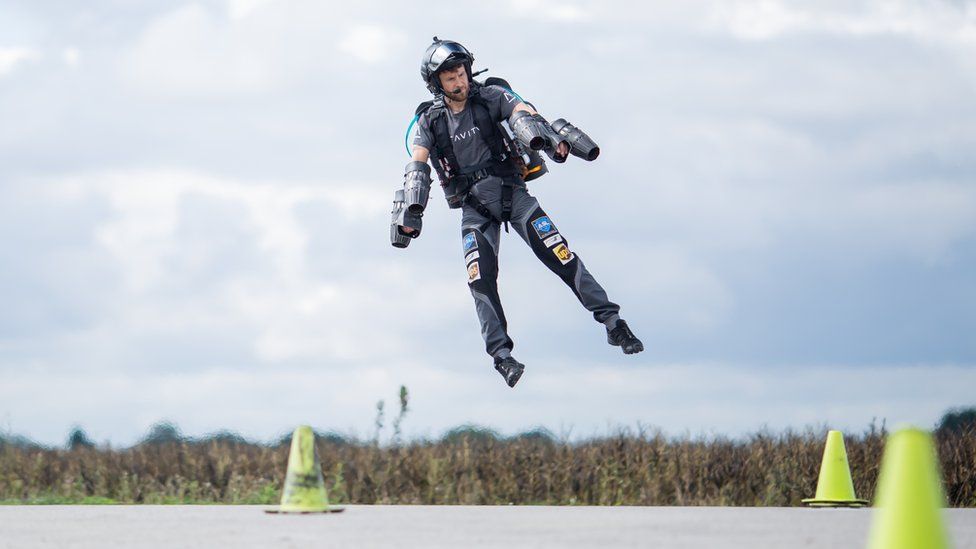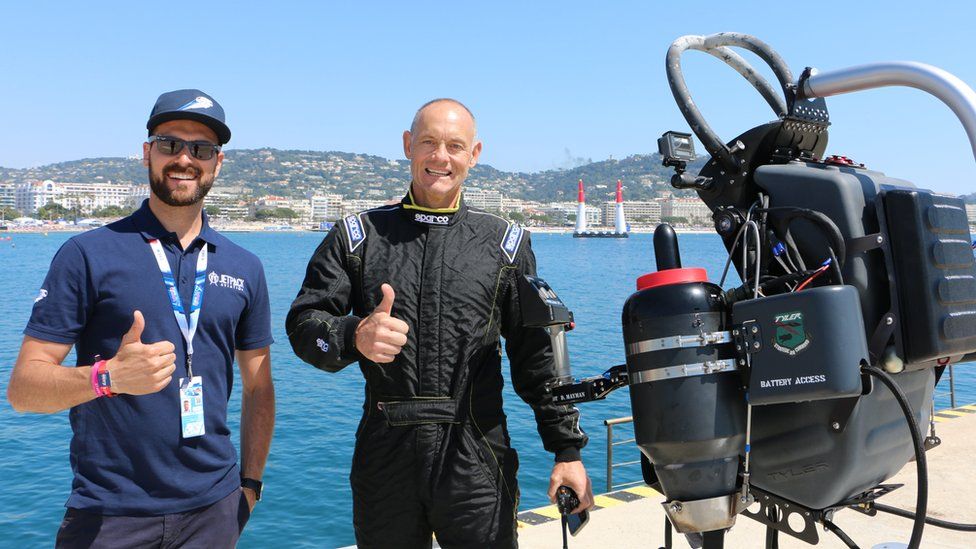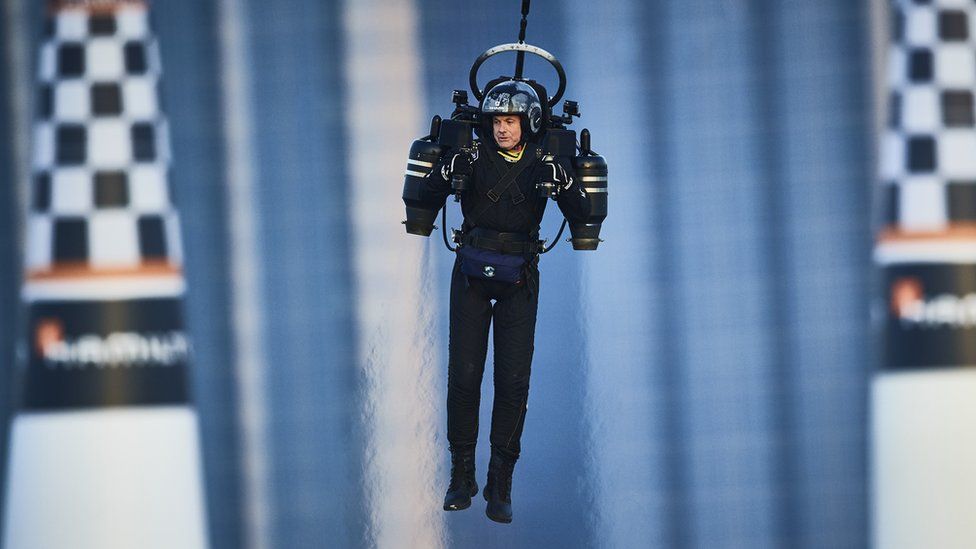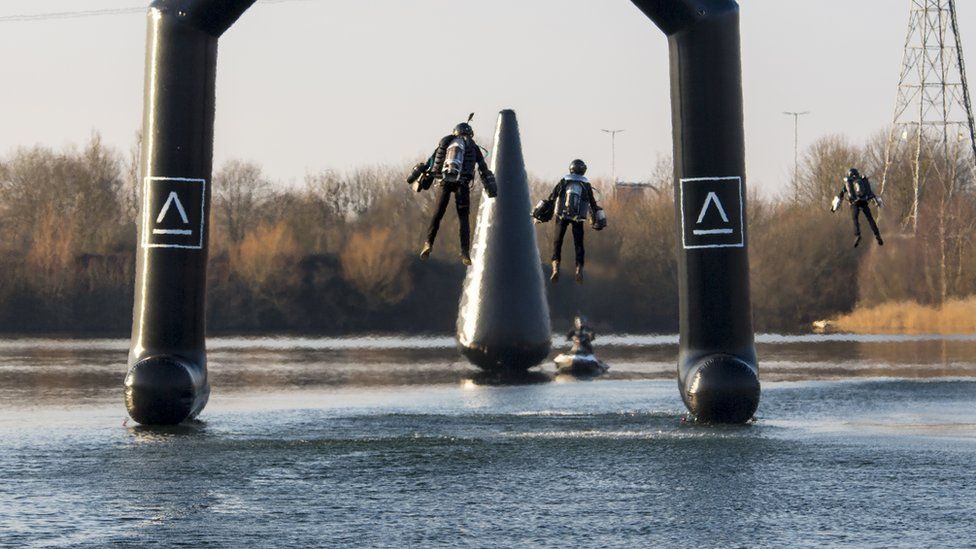
Leigh Coates says that when you speed through the air wearing a jetpack it feels as if you are able to fly like a superhero.
"It is an incredible feeling," says the retired US helicopter pilot. "You really do feel as if you can fly."
"They are really difficult to use though, to begin with."
Jetpacks first thrust into public consciousness around the world back in 1965, thanks to the James Bond movie, Thunderball.
The super spy, then played by the late Sean Connery, is chased by gunmen onto the roof of a French chateau, from where he straps himself into his jetpack to fly off and escape.
Providing a dramatic start to the film, the jetpack in question, a Bell-Textron, had been developed as a "man rocket" for the US Army in the 1950s.
While the US military ultimately deemed that it was too dangerous to use, it did the trick for secret agent 007, or at least Connery's stunt double.

Now 56 years later, jetpack technology has advanced considerably, and the equipment is being tested for a variety of specialist uses, such as the rapid deployment of rescue personnel in emergency situations, or for defence forces.
In fact, a dramatic video last month showed a Royal Marine testing out a jetpack to assist in maritime boarding operations, eliminating the need to descend on a rope from a helicopter.
What, however, is rarely discussed is the potential recreational use of jetpacks. Observers often point to a number of problematic issues, ranging from safety and environmental concerns - after all, you have a jet engine strapped to your back - to regulatory hurdles, and air traffic control issues.
Yet, two firms, one in the US, and one in the UK, are now allowing members of the public to pay to try out a jetpack, albeit with the user attached by wires to a large metal frame to prevent them from flying off uncontrollably.
Could this grow in popularity? And will the tethers be removed?

"I think that this technology will first be used in special cases, before finding a broader use in recreation," says Benjamin Akih, an associate professor of mechanical and aerospace engineering at Syracuse University in New York.
"I am thinking of fire-fighters, medical and rescue personnel, or possibly law enforcement… extensive use of jetpacks in these specialized cases may promote their adoption in other areas, such as recreation and personal travel."
Daniel Levine, a trends expert with the Avant-Guide Institute, a New York City-based consultancy that focuses on travel and consumer trends, said that while mass-produced recreational jetpacks are unlikely, tailor-made - and extremely expensive - jetpack "experiences" will become increasingly common. And users won't be tied down.
"I think in the next five years, deep-pocketed thrill-seekers will be able to rent jet packs in some country where insurance companies won't spoil the fun," he says. "My eye is on Dubai," he says.
"Once the tech is easy enough for the average Jane, personal propulsion vehicles will find a place - primarily as thrill rides."


New Tech Economy is a series exploring how technological innovation is set to shape the new emerging economic landscape.

Among the firms already well-established in the jetpack space is California-based, Jetpack Aviation, which was founded in 2015. It has already produced a number of versions of its "JB" series jetpack.
In addition to considering opportunities in the military and emergency services sectors, the company allows members of the public to be trained to use its Federal Aviation Administration-approved JB10, a twin-turbojet engine jetpack, that runs on kerosene or diesel.
JetPack Aviation founder and chief executive David Mayman says the firm has been "overwhelmed" by demand for its two days of training and - tethered - flights.

"We're overcapacity in terms of the number of people we can take. It's gone crazy," he says.
According to Mr Mayman, the jetpack - which his company touts as a '"Segway in the sky" - is intuitive to fly. Thrust and speed are controlled with the pilot's right hind, and directional movement by the left.
Meanwhile, a computer screen provides the user with information including the fuel level, engine, exhaust gas temperatures and battery status.
"The average person, of average size and average health, will have no problems," says Mr Mayman. "That's based on the number of people we've already trained.
"You certainly don't need to be a trained aviator, or an existing pilot. In fact, that sometimes slows people down because they have to unlearn a bunch of things."

Jetpack Aviation has now trained about 80 people, and Mr Mayman says that a number of promoters have approached him about setting up experience operations in countries including Japan and Australia.
It isn't cheap though, with the firm charging $4,950 (£3,600) for the two days training.
"It's an expensive exercise for us to run, because it's expensive technology," says Mr Mayman. [But] I think that over time it would become more affordable [thanks to future technological advances]."
In the UK, a rival firm called Gravity Industries also allows members of the public to try out its jetpack, although, again, with the user attached to a safety wire.
Both Gravity, which provides the jetpack being tested by the Royal Marines, and JetPack Aviation also say they are starting racing leagues. These will take place over water, for safety reasons.

Gravity had in fact planned to host its first race in Bermuda back in Mach 2020, but it had to be put on hold because of the pandemic.
The firm's founder, Richard Browning, a former oil trader and Royal Marine reservist, says that the planned race series will likely involve training members to the public to compete in events.
"We're going to let this evolve pretty organically, but we imagine we'll be training lots of members of the public," he says.
"They tend to be wealthy, charismatic kinds of men and women. Once they're trained, we'd want to meet up in iconic locations like Monaco, or the San Francisco Bay Area. We'd have a jetpack in their company colours prepared for them."

The race itself, he added, would likely involve jetpack-equipped racers swooping around pylons and performing manoeuvres for the duration of the jetpack's flight time, which at the moment is approximately five or six minutes.
"This would be something that can pop up once every couple of months in different, great locations around the world," Mr Browning adds. "That's the sort of model we were looking at. We want to demonstrate this, rather than hypothesize."
Leigh Coates hopes to compete in Gravity Industries' races. She was in fact the first woman to fly Gravity's jetpack un-tethered, back in 2019.
She has also flown, attached to a safety wire, with JetPack Aviation, back in 2018, for whom she was also the first woman to use its jetpack.
"It was my childhood dream to fly jetpacks," says Ms Coates, who lives in Alaska. "So when I found out about these two firms I leapt at the chance."
Additional reporting by Will Smale
"use" - Google News
July 05, 2021 at 06:01AM
https://ift.tt/36aw1xQ
Is the use of jetpacks finally about to take off? - BBC News
"use" - Google News
https://ift.tt/2P05tHQ
https://ift.tt/2YCP29R
Bagikan Berita Ini














0 Response to "Is the use of jetpacks finally about to take off? - BBC News"
Post a Comment